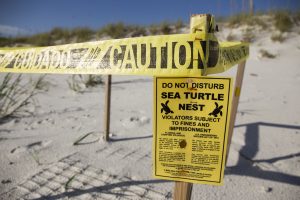
In Florida, this year’s sea turtle nesting numbers were record-breaking! 2023 state-wide statistics from the Florida Fish and Wildlife Commission (FWC) counted 133,941 loggerhead sea turtle nests. This is 30,000 nests more than average and breaks a record set in 2016! Green turtle nests were record breaking as well: 76,645 nests counted, more than 20,000 nests over the previous high record set in 2017! Of the 7 species of sea turtles worldwide, 4 nest in the Florida Keys: the loggerhead, green, leatherback, and hawksbill turtles. The Florida Keys have many critical nesting sites; you may have seen areas of the beach marked off to protect their nests. The Dry Tortugas and the Marquesas are the most productive nesting regions. In 2022, Monroe County counted 457 loggerhead and 481 green turtle nests. The most recent leatherback nest was in 2018. The Kemp’s Ridley turtle does not nest in the Florida Keys. A local fisherman, Richard Kemp, named this smallest sea turtle species in 1906. Kemp’s Ridley mainly nests in Mexico, although 10 nests were counted on Florida beaches in 2023. All of these species are on the endangered species list.
Female sea turtles do not nest every year. When they do, they typically lay 3 to 5 nests, although leatherback turtles may nest up to 11 times during a single nesting season. Frequent nesting is important because its estimated only 1 in 1,000 hatchlings survive to maturity. Trained and permitted volunteers walk the beaches at dawn to document nests and false crawls. A false crawl is when the female emerges from the water to nest but turns around without laying. Sea turtle nesting season is from March 1 to October 31 (Atlantic) or May 1 to October 31 (Gulf). Egg incubation lasts around 60 days. If you are interested in volunteering, the FWC holds volunteer training in the spring, and many local organizations are state-permitted, like Save-A-Turtle and the Key West Turtle Club.
Sea turtles travel thousands of miles over a lifetime, and the females usually return to the same beaches where they were born. The Marathon Sea Turtle Hospital frequently outfits sea turtles with satellite-tracking transmitters as part of the Tour de Turtles Race to follow their journeys after rehabilitation. A juvenile green sea turtle named Marcia was released in July 2023 and recorded 170 miles. Typical for green turtles, Marcia tends to stay nearshore, where she eats seagrass. Marcia actually scored last place this year, and the winner was Bella, a hawksbill turtle who logged over 1,800 miles in under a month from her release in Puerto Rico to the Bahamas. Sea turtles face many threats, including boat strikes, plastic debris, rising water temperatures, light pollution, poaching, and habitat loss. For more information, visit the Marathon Sea Turtle Hospital, which is open for daily tours and is a terrific to-do for residents and visitors alike!

The collaborative work of government agencies, conservation organizations, and local communities proves that it is possible to rebuild endangered species populations. The success story of sea turtle recovery in Florida results from policies designed to protect them. Shrimp boats are mandated to use turtle excluder devices (TEDs) that keep turtles out of shrimp nets. Ordnances to limit light pollution during nesting season have reduced the number of disoriented nesting females and hatchlings that need a dark sky to follow the moonlight on the horizon. Hawksbill turtles were harvested for their tortoiseshell to make eyeglasses, jewelry, and hair combs. The green sea turtle fishery ended in 1973. Before that, thousands were caught, cooked, and canned for turtle consommé. In recent decades, conservation efforts have been instrumental in ensuring the triumph of these endangered species. When there is a concerted effort to fix the conditions that cause species decline, the road to recovery can be realized.
 5
5
